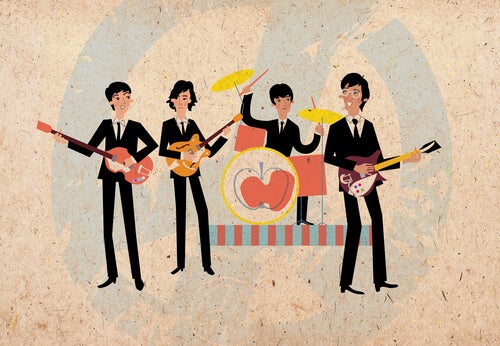Subliminal Messages in Music: Myth or Reality?

The question of whether or not there can be subliminal messages in music has always been enveloped in controversy. For some, it’s simply a myth. However, for others, it’s an unimportant anecdote. Others even believe that think these messages are really capable of changing people’s behavior and influencing their values.
There’s still no definitive conclusion regarding subliminal messages in music or in images. Actually, the available data is contradictory. Several governments have banned these types of messages. However, most researchers have distorted their real effectiveness.
The issue gets new attention every once in a while. Indeed, it’s caused everything from laughter to major worry. Sometimes, people blame subliminal messages in music for inciting violence, practicing satanism, or using drugs. Can any of this be really true?
“I saw a subliminal advertising executive, but only for a second.”
-Steven Wright-

Some history
Subliminal messages are designed to come through under the limits of normal perception. In other words, people can’t perceive them consciously, so they supposedly receive them without realizing it.
People were talking about these types of messages as early as a thousand years ago. Aristotle claimed that impulses could go by unnoticed when people were awake, but then reappear strongly when they were asleep. Likewise, Michel de Montaigne, O. Poetzle, and later Sigmund Freud also talked about these types of unconscious experiences.
However, advances in technology made it possible to really try some things out. By the 20th century, this type of communication was actually possible.
In 1957, scientists conducted a famous experiment with subliminal messages in images. Almost a decade later, The Beatles got everyone talking about subliminal messages in music or “backmasking”.
Subliminal messages in music
Subliminal messages in music or “backmasking” are inserted through a special recording technique. Someone records a sound or message backward on a track that’s meant to be played forward. Thus, the listener can only consciously hear the message if they listen to it backward.
Two major factors led to subliminal messages in music. The first came from “concrete music” in France. This genre used electronic instrument sounds with sounds from the environment and combined them in the recording studio.
The second factor was the use of recordable tape to record and conserve the original performances of musicians. This allowed technicians to combine, cut, record over, and paste fragments of the original recording.
The Beatles, and John Lennon in particular, conducted a variety of experiments with “concrete music”. Thus, they started an entirely new chapter of the story.
The Beatles’ seventh album included subliminal messages. For the first time, there was a song in which words had been recorded backward. That song, “Rain”, came out in 1966. The band wanted to satirize, experiment, and put out some new sounds, and subliminal messages were a great way to do so. From that point on, many artists did the same thing. Therefore, subliminal messages in music became more common.

Questions that persist
Predictably, several religious movements began to preach against subliminal messages. As a result, urban legends about them also gained traction. Many people listened to tapes backward and found hidden meanings, but the majority of their assertions were just wild guesses.
Religious people, in particular, accused various rock bands of enticing young people to worship the devil, commit crimes, and do drugs. The debate continued to rage until, in 1985, psychologists John R. Vokey and J. Don Read conducted an experiment. They recorded a Psalm from the Bible and observed the reactions of the listeners.
These researchers concluded that subliminal messages in music didn’t have any effect. In 1996, C. Trappery conducted 23 experiments, which basically yielded the same conclusions. However, Utrecht University researchers Johan C. Karremansa, Wolfgang Stroebeb, and Jasper Claus conducted a new experiment in 2006. They concluded that apparently these messages do change people’s behavior. The debate continues!
The question of whether or not there can be subliminal messages in music has always been enveloped in controversy. For some, it’s simply a myth. However, for others, it’s an unimportant anecdote. Others even believe that think these messages are really capable of changing people’s behavior and influencing their values.
There’s still no definitive conclusion regarding subliminal messages in music or in images. Actually, the available data is contradictory. Several governments have banned these types of messages. However, most researchers have distorted their real effectiveness.
The issue gets new attention every once in a while. Indeed, it’s caused everything from laughter to major worry. Sometimes, people blame subliminal messages in music for inciting violence, practicing satanism, or using drugs. Can any of this be really true?
“I saw a subliminal advertising executive, but only for a second.”
-Steven Wright-

Some history
Subliminal messages are designed to come through under the limits of normal perception. In other words, people can’t perceive them consciously, so they supposedly receive them without realizing it.
People were talking about these types of messages as early as a thousand years ago. Aristotle claimed that impulses could go by unnoticed when people were awake, but then reappear strongly when they were asleep. Likewise, Michel de Montaigne, O. Poetzle, and later Sigmund Freud also talked about these types of unconscious experiences.
However, advances in technology made it possible to really try some things out. By the 20th century, this type of communication was actually possible.
In 1957, scientists conducted a famous experiment with subliminal messages in images. Almost a decade later, The Beatles got everyone talking about subliminal messages in music or “backmasking”.
Subliminal messages in music
Subliminal messages in music or “backmasking” are inserted through a special recording technique. Someone records a sound or message backward on a track that’s meant to be played forward. Thus, the listener can only consciously hear the message if they listen to it backward.
Two major factors led to subliminal messages in music. The first came from “concrete music” in France. This genre used electronic instrument sounds with sounds from the environment and combined them in the recording studio.
The second factor was the use of recordable tape to record and conserve the original performances of musicians. This allowed technicians to combine, cut, record over, and paste fragments of the original recording.
The Beatles, and John Lennon in particular, conducted a variety of experiments with “concrete music”. Thus, they started an entirely new chapter of the story.
The Beatles’ seventh album included subliminal messages. For the first time, there was a song in which words had been recorded backward. That song, “Rain”, came out in 1966. The band wanted to satirize, experiment, and put out some new sounds, and subliminal messages were a great way to do so. From that point on, many artists did the same thing. Therefore, subliminal messages in music became more common.

Questions that persist
Predictably, several religious movements began to preach against subliminal messages. As a result, urban legends about them also gained traction. Many people listened to tapes backward and found hidden meanings, but the majority of their assertions were just wild guesses.
Religious people, in particular, accused various rock bands of enticing young people to worship the devil, commit crimes, and do drugs. The debate continued to rage until, in 1985, psychologists John R. Vokey and J. Don Read conducted an experiment. They recorded a Psalm from the Bible and observed the reactions of the listeners.
These researchers concluded that subliminal messages in music didn’t have any effect. In 1996, C. Trappery conducted 23 experiments, which basically yielded the same conclusions. However, Utrecht University researchers Johan C. Karremansa, Wolfgang Stroebeb, and Jasper Claus conducted a new experiment in 2006. They concluded that apparently these messages do change people’s behavior. The debate continues!
All cited sources were thoroughly reviewed by our team to ensure their quality, reliability, currency, and validity. The bibliography of this article was considered reliable and of academic or scientific accuracy.
Navarro, A. B. B. (2005). El mensaje subliminal: tácticas de publicidad ilícita. In Información para la paz: autocrítica de los medios y responsabilidad del público (pp. 169-182). Fundación COSO de la Comunidad Valenciana para el Desarrollo de la Comunicación y la Sociedad.
This text is provided for informational purposes only and does not replace consultation with a professional. If in doubt, consult your specialist.







